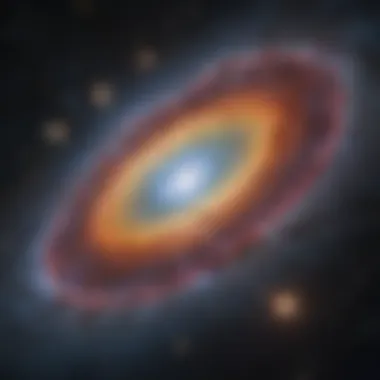Unraveling the Enigma: The Timeline of the Big Bang Theory


Interactive Learning Games
The Big Bang theory stands as a cornerstone in cosmology, unraveling the mysteries of the universe's birth. Imagine a point of infinite density and temperature—conditions unimaginable to the human mind—exploding and giving birth to the vast expanse we inhabit today. This cataclysmic event occurred approximately 13.8 billion years ago, sparking the beginning of space, time, and matter. The ramifications of the Big Bang extend far beyond mere history; they dictate the very essence of existence and our place within the cosmos.
Educational Topics
- Tips and Tricks
Creative DIY Projects
Step-by-Step Guides
Craft Ideas
Introduction
The Big Bang theory is a cornerstone in cosmology, unraveling the mysteries of the universe's inception. As we delve into the realms of space and time, understanding the precise moment when the Big Bang occurred becomes paramount. This article embarks on a journey to illuminate the origins and implications of this significant cosmological event, providing a detailed exploration of the timeline of the Big Bang theory. By scrutinizing the epoch of the Big Bang, we can grasp the fundamental principles that govern our universe's evolution, offering profound insights into the nature of existence.
Definition of the Big Bang
The term 'Big Bang' encapsulates the concept of the universe originating from an infinitesimally compact singularity and undergoing rapid expansion. This theory posits that all matter, energy, and space itself came into being from a singular point, triggering the cosmic evolution we witness today. Through meticulous observations and theoretical models, scientists have constructed a robust framework to elucidate the dynamics of this primordial moment. By comprehending the definition of the Big Bang, we lay a foundation for deciphering the fundamental forces driving the universe's development.
Importance of Understanding the Big Bang
Comprehending the Big Bang holds profound significance in unraveling the universe's mysteries and elucidating the cosmic tapestry that encompasses us. By grasping the intricacies of how the universe commenced its expansion, we gain invaluable insights into the processes that shaped galaxies, stars, and ultimately life itself. The importance of understanding the Big Bang extends beyond theoretical physics, touching upon existential questions about the nature of reality and our place in the vast cosmos. Through exploring the depths of this foundational theory, we embark on a journey of intellectual discovery and enlightenment.
Overview of the Article
This article serves as a comprehensive guide to unravelling the enigma of when the Big Bang occurred. Beginning with an exploration of the key concepts and definitions underpinning the Big Bang theory, we gradually delve into the importance of comprehending this monumental event. With an intricate overview of the article, readers will navigate through the timeline of the Big Bang, unravelling the cosmic epochs that shaped our universe's destiny. By synthesizing the information presented, readers will gain a profound understanding of the significance of the Big Bang theory in deciphering the mysteries of the cosmos.


Theoretical Background
When delving into the complexities of the Big Bang theory, it is imperative to grasp the foundational underpinnings of the theoretical background. This segment serves as the bedrock upon which our understanding of the universe's origins is built. The theoretical background provides a framework for interpreting observational data and formulating hypotheses that explain the universe's evolution. A thorough exploration of the theoretical background illuminates the rationale behind cosmological models and the significance of key concepts in shaping our current understanding of the Big Bang.
Key Concepts in Cosmology
Expending Universe
The Expanding Universe theory elucidates the notion that galaxies are moving away from each other, suggesting that the cosmos is continuously growing in size. This concept revolutionizes how we perceive the universe's dynamics, offering crucial insights into its expansion over vast timescales. The expanding Universe theory plays a pivotal role in understanding the cosmic landscape, providing a mechanism for comprehending the distribution of celestial bodies and the overall structure of the cosmos. Although the expanding Universe theory poses challenges in reconciling certain observations with theoretical predictions, its capacity to explain the redshift of galaxies and the cosmic microwave background radiation underscores its indispensable significance in cosmological studies.
Cosmic Microwave Background Radiation
Cosmic Microwave Background Radiation (CMB) stands as a cornerstone in modern cosmology, representing a relic from the early universe's hot and dense phase. The detection of CMB has been instrumental in validating the Big Bang theory, offering compelling evidence for the universe's initial rapid expansion. This pervasive radiation permeates the cosmos, carrying crucial information about the universe's early conditions and evolution. The unique isotropy of CMB provides insights into the uniformity of the universe on large scales, substantiating key cosmological principles. Despite its critical role in confirming cosmological models, the study of CMB presents challenges in distinguishing primordial signals from foreground contaminants, necessitating sophisticated observational techniques and meticulous data analysis.
Inflation Theory
The Inflation Theory hypothesizes a brief period of exponential expansion in the early universe, addressing key questions that traditional Big Bang cosmology struggles to explain. This rapid inflationary phase offers a compelling solution to cosmological puzzles such as the horizon problem and the flatness problem, elucidating the uniformity and geometry of the universe on cosmological scales. Inflationary models introduce theoretical frameworks that enhance the predictive power of cosmology, aligning theoretical predictions with observed phenomena to a remarkable degree. Despite its remarkable success in resolving long-standing cosmological conundrums, inflation theory faces challenges in experimental verification and theoretical refinement, prompting ongoing debates within the scientific community regarding its implications for our understanding of the cosmic origins.
This detailed exploration of key concepts in cosmology sheds light on the intricate fabric of the universe's history, underscoring the nuanced interplay between theoretical frameworks and observational evidence in deciphering the mysteries of the cosmos.
Development of the Big Bang Theory
The section on the Development of the Big Bang Theory delves into the evolution of this groundbreaking concept, tracing its origins and the pivotal contributions that have shaped our understanding of the universe. By exploring the development of the Big Bang Theory, we gain valuable insights into the complexities of cosmology and the ways in which scientific thought has progressed over time. Understanding the timeline of how this theory came into being allows us to appreciate the vast body of knowledge that underpins modern astrophysics, making it a cornerstone of cosmological studies and a essential part of our quest to unravel the mysteries of the universe. The development of the Big Bang Theory serves as a cornerstone for modern cosmology, providing a framework that has revolutionized our perception of the cosmos.
Early Theories of the Universe
Steady State Theory
The Steady State Theory was a pivotal concept in early cosmological thought, proposing a universe that remains constant over time, with no beginning or end. This theory posited a continuous creation of matter to maintain a dynamic equilibrium in the cosmos, challenging the notion of a singular explosive origin. Despite its intriguing premise, the Steady State Theory eventually gave way to the overwhelming evidence supporting the Big Bang Theory's dynamism and evolution aspect, thereby gaining widespread acceptance as a cornerstone of cosmology.
Static Universe Model


In the realm of cosmology, the Static Universe Model presented an intriguing alternative to expanding universe theories. This model suggested a universe devoid of dynamic expansion or contraction, remaining unchanged throughout eternity. While the concept of a static universe offered a compelling intellectual challenge, observational evidence ultimately supported a universe in constant motion, reinforcing the narrative of cosmic evolution. The Static Universe Model serves as a testament to the complexity of universe theories and the dynamic interplay between theoretical frameworks and empirical data in shaping our understanding of the cosmos.
Contributions of Georges Lemaitre
Formation of the Big Bang Theory
Edwin Hubble's Discoveries
George Gamow's Nucleosynthesis Theory
Timeline of the Big Bang
In understanding the intricacies of the Big Bang, the timeline plays a pivotal role. The timeline of the Big Bang provides us with a roadmap of the universe's evolution from its inception, offering a chronological sequence of key epochs and events that shaped the cosmos. By delving into the timeline of the Big Bang, we gain insights into the fundamental processes that occurred during the universe's early moments, helping us unravel the mysteries of its origin and development. This section will unravel the significance and impact of each epoch, shedding light on how each phase contributed to the formation of the universe as we know it today.
Planck Epoch
The Planck Epoch marks the earliest stage of the universe, characterized by extreme energy densities and temperatures beyond our current comprehension. During this epoch, the fundamental forces of nature were unified, and the fabric of spacetime underwent quantum fluctuations. These primordial fluctuations laid the foundation for the formation of structures in the universe. Understanding the Planck Epoch provides us with a glimpse into the universe's initial conditions and sets the stage for the subsequent epochs to follow.
Grand Unification Epoch
As we delve into the Grand Unification Epoch, we confront a phase where gravity separates from the other fundamental forces. This epoch brims with unification theories aiming to merge electromagnetism, weak nuclear force, and strong nuclear force under a single overarching force. Exploring the Grand Unification Epoch unveils the quest for a unified theory of particle physics, elucidating how the forces governing the universe diverged from a singular entity to the distinct forces we recognize today.
Electroweak Epoch
Transitioning into the Electroweak Epoch, we witness the electroweak force separating from the strong force. This separation engenders the distinct behaviors of particles and forces, shaping the trajectory of particle interactions in the nascent universe. The Electroweak Epoch heralds a critical juncture in the universe's evolution, delineating the moment when electromagnetic and weak nuclear forces manifest their unique characteristics, paving the way for particle diversity and interaction dynamics.
Quark Epoch
Emerging into the Quark Epoch, the universe undergoes significant transformations as quarks assemble to form protons and neutrons. This epoch witnesses the evolution of quark-gluon plasma, where quarks and gluons roam freely before coalescing into bound particles. Unraveling the dynamics of the Quark Epoch elucidates the primordial soup of particles that laid the groundwork for the formation of atomic nuclei and subsequent elements in the universe.


Hadron Epoch
Transitioning through the Hadron Epoch, protons and neutrons bind together to form atomic nuclei, kickstarting the synthesis of light elements like hydrogen and helium. The Hadron Epoch marks a crucial phase in nucleosynthesis, shaping the elemental composition of the cosmos and paving the way for the diversity of matter we observe in the universe today. Exploring the Hadron Epoch unveils the intricate processes governing nuclear interactions and element formation in the early universe.
Lepton Epoch
The Lepton Epoch encompasses a period where leptons such as electrons and neutrinos dominate the universe due to their interactions with photons and neutrinos. This epoch plays a vital role in understanding particle interactions and neutrino oscillations that sculpted the universe's particle content and energy distribution during its infancy. By delving into the Lepton Epoch, we grasp the intricacies of leptonic interactions that influence the universe's composition and temperature fluctuations at cosmic dawn.
Photon Epoch
Navigating through the Photon Epoch, we traverse a phase where photons reign supreme, interacting with the baryonic matter and shaping the cosmic microwave background radiation we detect today. The Photon Epoch unravels the density and temperature fluctuations imprinted on the cosmic microwave background, offering a glimpse into the early universe's luminous era and the structural seeds that seeded galaxies and cosmic structures.
Nucleosynthesis Epoch
In the Nucleosynthesis Epoch, primordial nucleosynthesis occurs, synthesizing light elements like helium, deuterium, and lithium through nuclear reactions. This epoch delineates the genesis of the light element abundance observed in the universe today, providing crucial insights into the stellar nucleosynthesis processes that sculpted the chemical composition of galaxies and stars. Discovering the Nucleosynthesis Epoch unravels the cosmic alchemy that forged the elemental diversity we encounter in the cosmos.
Abundance of Light Elements
One compelling aspect lending credence to the Big Bang theory is the Abundance of Light Elements present in the universe. The primordial nucleosynthesis that transpired in the first few minutes after the Big Bang gave rise to the formation of light elements, primarily hydrogen, helium, and trace amounts of lithium. Observations of cosmic elemental abundances in stars, galaxies, and the interstellar medium corroborate the expected ratios established by Big Bang nucleosynthesis models. The consistency between theoretical predictions and observed elemental compositions serves as compelling evidence supporting the notion that the universe evolved from a hot, dense state into its current cosmic tapestry. By scrutinizing the abundance of light elements throughout the cosmos, astronomers can validate the predictions set forth by the Big Bang theory and unravel the intricate workings of cosmic evolution.
Formation of Cosmic Structures
The formation of cosmic structures stands as a testament to the profound impact of the Big Bang on shaping the universe's intricate tapestry of matter and energy. This section delves into the complexities of how galaxies, clusters, and superclusters have evolved over billions of years, reflecting the underlying principles of cosmic organization.
Integral to the formation of cosmic structures is the gravitational collapse of primordial matter under the influence of dark matter, a mysterious component that pervades the universe and interacts primarily through gravity. Dark matter acts as the cosmic scaffold upon which ordinary matter congregates, leading to the formation of large-scale structures like galaxy clusters and filaments. Its invisible presence profoundly shapes the distribution of matter in the universe, influencing the paths of galaxies and determining the cosmic web's intricate network.
Furthermore, the hierarchical assembly of cosmic structures over cosmic time reveals the dynamic interplay between gravitational attraction and cosmic expansion. Galaxies coalesce into groups, merging to form larger clusters bound by gravity, creating immense structures that span millions of light-years. Understanding the formation of cosmic structures unveils the underlying principles governing the universe's large-scale organization and sheds light on the vast cosmic web connecting galaxies across the cosmos.
By exploring the formation of cosmic structures, we gain a deeper appreciation for the cosmic symphony of matter and energy, where gravitational forces sculpt intricate patterns across cosmic scales, shaping the rich tapestry of the universe's material composition and cosmic architecture.
Conclusion
In the grand tapestry of cosmology, the conclusion segment serves as a pivotal juncture, where the disparate threads of the Big Bang theory are woven together to unveil the profound implications of this cosmological phenomenon. This section encapsulates the essence of when the Big Bang happened, elucidating the timeline of events that led to the genesis of our universe. The importance of comprehending the exact moment of the Big Bang cannot be overstated, as it fundamentally shapes our understanding of the cosmos's evolution. By dissecting the intricacies of the Big Bang's occurrence, we gain insights into the very fabric of space, time, and existence.
Summary of Key Points
Examining the chronological landscape of the Big Bang's inception, it becomes evident that pinpointing the precise moment of this cataclysmic event is no trivial task. From the Planck Epoch to the Nucleosynthesis Epoch, each phase in the timeline of the Big Bang unfolds with intricate detail and cosmic significance. The cosmic microwave background radiation forms a crucial piece in the puzzle of understanding the Big Bang's occurrence, providing tangible evidence for the theory's validity. Furthermore, the redshift of galaxies offers a window into the past, allowing astronomers to trace the universe's expansion back to its primordial origins. The evidence, spanning from the abundance of light elements to the formation of cosmic structures, paints a vivid picture of the universe's extraordinary genesis and evolution.















